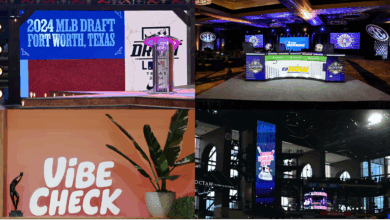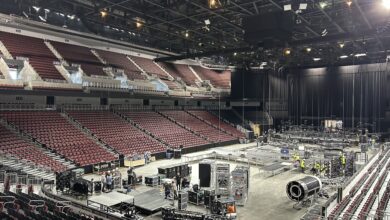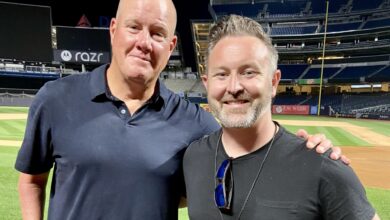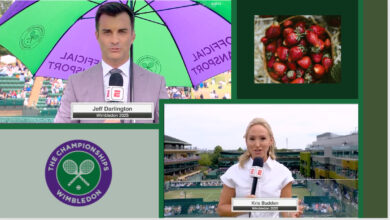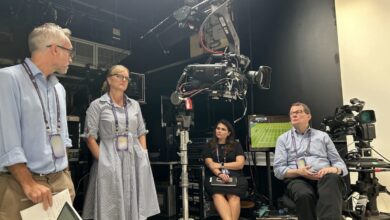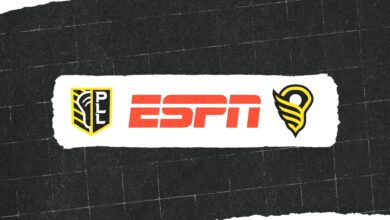How I Got Here: Cara Capuano
Editor’s note: How did you join ESPN? Front Row provides interesting answers with “How I Got Here” profiles. ESPNU/SEC Network anchor/reporter/play-by-play announcer Cara Capuano tracks her journey from scientist to sports journalist.
Every Saturday during college football season, you’ll find me working the sidelines for the SEC Network (check out my blog at: http://espnplus.com/blog/).
I’m also a sideline reporter for college football and basketball on the ESPN Networks, primarily ESPNU.
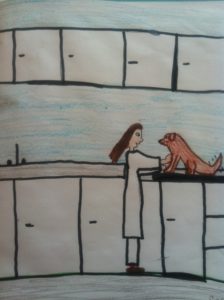
I call play-by-play for women’s basketball and softball and serve as studio host on a variety of specialty shows, typically involving those sports or the SEC.
But if you knew me a few years ago, sportscasting didn’t seem to be my career destination.
The first love was math. I remember starting kindergarten and being sent to second grade during math time. Then followed my love for science. The tangible evidence can still found at my house today.
Every childhood autobiography had me forecasting the same future: veterinary medicine — until that ill-fated high school assembly.
We’ve all been to this one: It was timed right before homecoming, where administrators hammer home a poignant anti-drunk driving message by showing a gym full of teenagers the most graphic car accident images they can find.
I leaned over to my best friend and said, “I feel a little light-headed.”
Next thing I knew, my head was in my lap and I was sitting cross-legged, turned 180 degrees from the direction I had originally been facing, asking the school nurse, “What is that?”
Smelling salts.
Yep, I fainted.
Even at 15, I knew that first fainting incident (there have been many since) wasn’t a good sign for a budding pre-veterinary science major.
But the love for science wouldn’t subside, despite my squeamish nature.
Enter the University of California, San Diego, one of the finest research institutions in America.
I spent my four years there either attending class, teaching class or at the Central Library (now called Geisel Library, following a ginormous donation by the man you know as Dr. Seuss.)
If I studied facing west on the higher floors, I could see the ocean and hang-gliders along the cliffs of La Jolla.
Yes, this is where I went to college. Tough life, right?
In a way, it was.
U.C.S.D. was NCAA Division III in those years.
That’s tough sports-fan sledding for a gal who first joined the “Blue Crew” (Los Angeles Dodgers fan club) at age 3. I also grew up idolizing the “Showtime” Lakers, and was one of 80-thousand-plus fans rooting for the Los Angeles Raiders at the AFC Championship Game at the Memorial Coliseum in 1984. The Raiders won the Super Bowl that year (thanks, Dad, but I can’t deny Mom’s influence: She took me to the classic UCLA-USC game at the very same Coliseum which pitted Rodney Peete of USC versus Troy Aikman’s UCLA Bruins.)
I decided to adopt the Arizona Wildcats as my “college team” and made many treks to Tucson for big-time games.
Think [former Arizona football coach] Dick Tomey and “Desert Swarm” (ask ESPN.com’s Pat Forde who inspired the “APB” on NT Rob Waldrop last year? Yours truly!)
Think [former Wildcats men’s basketball coach] Lute Olson and his perfect hair; Damon Stoudamire and Khalid Reeves, then Mike Bibby and Miles Simon and an unexpected National Championship.
Even while I was thriving in my classes, the “fan”aticism in me was reaching a fever pitch.
The foundation was laid. A crossroads was on the horizon.
On college graduation day, I sat on stage, recognized for earning the “Highest GPA in the Major: Biochemistry and Cell Biology.”
Only one B-plus litters my transcript, from my first quarter of general chemistry (8 a.m. class, three days a week: classic freshmen miscalculation!)
For the most part, I was a curvesetter in my Bio classes, to the chagrin of many pre-med friends.
My veterinary dreams may have evaporated, but I’d found a new love: teaching.
The goal: junior college biology instructor.
The demand: at least a master’s degree, a Ph.D. would increase my chances at landing an even better job.
To increase my appeal to graduate programs, I spent senior year as an undergraduate researcher in a cell biology lab, constructing faux nuclei to be used in protein trafficking experiments.
Between that valuable experience, my GPA and a score in the 93rd percentile on the Biology-specific GRE, I was recruited like a five-star athlete.
What a wonderful feeling, to be truly wooed!
Official visits included campus tours and extensive interviews, followed by dinners at the homes of the department heads.
There were follow-up phone calls from some of the world’s most prominent professors.
All five schools I applied to accepted me. Stanford was reserving one of four spots in its prestigious “Cancer Biology” program for me, but in the end, I chose UCLA.
In the back of my mind, a small candle burned for the possibility of a future as a television sportscaster.
Stranding myself in Palo Alto (called “The Farm” for good reason) seemed like a no-win situation for my “other” potential career goal.
Kids, that’s what we call a “self-fulfilling prophecy.”
One year of classes, seminars and laboratory rotations later, I took a “leave” from UCLA, found a string of odd jobs to pay my bills and began to volunteer weekends in the sports department at a local TV news station.
It started with logging games and editing highlights, then moved into gathering postgame reaction at local events (you name it, L.A. has it – with two MLB, NHL and NBA teams).
Eventually, I was producing weekend sportscasts and compiling a resume reel to land my first on-air job. I loved every minute of those grueling 7-day work weeks, and still do.
The credits I earned in Year 1 of my Ph.D. pursuit in Biological Chemistry are still present in UCLA’s records.
I followed up with the registrar a few years ago, playing with the idea of completing my Master’s. I might still go back.
For now, I’m blissfully content in my role as a “student of the game”: traveling to a different campus every weekend from September through May, learning and sharing the stories of student-athletes and their coaches, celebrating our shared love of sports.
It’s a dream career discovered, albeit on a circuitous path.
And all of that studying at Central Library serves me well when I have to remember considerable details about the teams players I’m covering.
My molecular model set sits in my office, a fond reminder of my roots.
